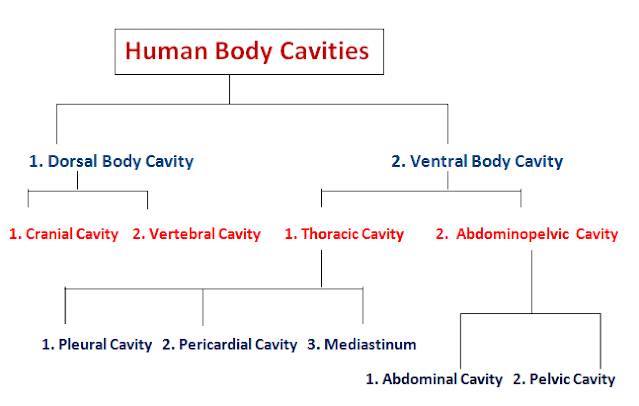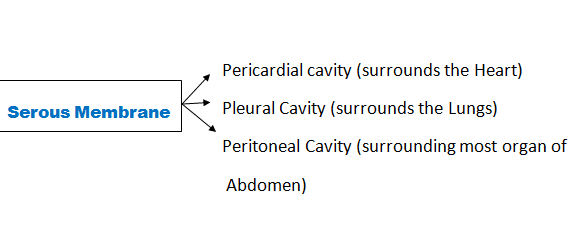Cavities of the Body and Their Subdivisions
Body cavities are confined (limited) space within the body that contains internal organs or viscera.
A body cavity is a fluid-filled space inside the body that houses organs, holds the organs, and protects internal organs.
The cavities refer to any space or compartment or “hollow space”. The cavity of the body is differentiated or separated by membranes and other structures bones, muscles, or ligaments.
Know here the anatomical position of the body and directional terms.
Human Body Cavities
The two main body cavities are –
1. Ventral or anterior cavity, and
2. Dorsal cavities or posterior cavity

1. Dorsal Body Cavity
It is located near the dorsal surface (back) of the body. The dorsal body cavity includes; the brain and vertebralcord(spinal cord).
Subdivision of dorsal cavity are-
A. Cranial Body Cavity
B. Vertebral Body Cavity
A. Cranial Body Cavity
The cranial body cavity is formed by skull bone that contains the brain.
The cranial cavity is enclosed by the skull and contains the brain.
B. Vertebral Body Cavity
The vertebral body cavity is formed by vertebrae of the backbone, contains the vertebral cord (spinal cord) and spinal nerves.
The spinal cavity is enclosed by the spine and contains the spinal cord.
2. Ventral Body Cavity
It is located on the ventral (front), anterior surface of the body. A lined by thin, slippery tissue called serous membrane lines the wall of the ventral body cavity and organs within it.
The ventral cavity allows for significant changes in the size and shape of the internal organs within, perform their functions.
The organs inside is called viscera. Double-walled sacs of serous membrane surround these cavities.
The two walls (membrane) that make up these sacs are separated by a thin film of serous fluids, which act as a lubricant and facilitate the nearly frictionless movements of an organ such as the heart, lungs, and stomach.
Subdivisions of a ventral body cavity are-
A. Thoracic Body Cavity
B. Abdominopelvic Body Cavity
A. Thoracic Body Cavity
The thoracic cavity is protected by the thoracic cage (rib cage) and its associated musculature (arrangement of muscle) and sternum anteriorly and 12 thoracic vertebrae posteriorly.
The thoracic cavity is separated from the abdominal cavity by the diaphragm.
Thoracic cavity contains three compartments-
1. Pleural Cavity
There are two pleural cavities present; right and left. Each of two pleural cavities surrounds the lungs.
Each pleural cavity is a small, fluid-filled space between the parts of the serous membrane that covers the lung (visceral pleura) and the part that lines the walls of the thoracic cavity (parietal pleura).
The pleural cavity or pleural space is bounded by a double-layered serous membrane called “pleura”.
The serous membrane associated with the lungs is called “pleura”.
2. Pericardial Cavity
The pericardial cavity is a fluid-filled space between the parts of the serous membrane that covers the heart (visceral pericardium) and the part that lines the thoracic cavity (parietal pericardium).
The serous membrane that surrounds the heart is called the “pericardium”.
Pericardial fluid (serous fluid) acts to reduce surface tension, lubricates the cavity, and facilitates the free movement of the heart.
3. Mediastinum
The mediastinum is the region between the lungs extending from the sternum to the vertebral column or backbone.
Space between both lungs inside the chest cavity between right and left lung. It is a central compartment of the thoracic cavity, located between the two pleural sacs.
The mediastinum contains all the contents of the thoracic cavity except for the lung themselves.
It contains a heart and its attached blood vessels, pericardial cavity, esophagus, trachea, thymus gland, lymph nodes, thoracic duct, phrenic nerves, and vagus nerves.

B. Abdominopelvic Body Cavity
The abdominopelvic body cavity is the largest cavity in the body, consists of the abdominal cavity and the pelvic cavity. It extends from the diaphragm inferiorly to the floor of the pelvis. It is bounded primarily by abdominal muscles.
It is divided by an imaginary line at the superior margin of the pelvis into the superior abdominal cavity and inferior pelvis cavity.
A serous membrane that lines the abdominopelvic cavity and covers the organs within it, called the “Peritoneum”.
Check out here what are quadrants and regions of abdomen?
The abdominopelvic body cavity contains two compartments-
1. Abdominal Cavity
The abdominal cavity contains; the stomach, liver, kidney, spleen, gall bladder, pancreas, small intestine, and most of the large intestine.
2. Pelvic Cavity
The pelvic cavityis directly continuous with the rest of the abdomen but is situated in the space bounded by the sacrum bone behind, the ischium bone on each side, and the pubic bone (pubis) in front.
The pelvic cavity contains; the urinary bladder, sigmoid colon (pelvic colon), rectum, lower parts of ureters, internal portions of the male and female reproductive system, inferior portion of the peritoneal cavity, and some loops of the small intestine.
What organs are found in the abdominopelvic regions? Check out here abdominopelvic regions and quadrants organs.
Functions of Body Cavity
1. The cavities help to protect, separate, and support the internal organ.
2. Cavities permit the internal organs to a significant change in size and shape of an organ without disrupting the activities of nearby organs.
3. They act as cushions or shock absorbers while walking, jumping, or running.
4. Cavities of the body house and protect the internal organs.
Check out here what are anatomical planes and sections of the Body?


